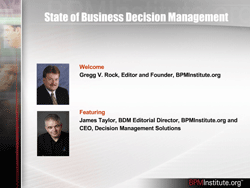Decision Management, Business Decision Management as we call it here at the BPMInstitute.org, is both an approach and a technology stack for automating and improving business decisions.
James Taylor
Member since
Dec 12, 2005

Analytics/Big Data
Business Architecture (BA)
Business Decision Management (BDM) / Business Rules (BR)
Business Process Management (BPM)
Articles by: James Taylor
Creating Agility and Operational Efficiency with Decision Modeling
Decision modeling is designed to bridge the gap between business processes and the key decision-making technologies needed to transform traditional processes with digital decisioning, which typically includes both business rules management systems (BRMS) and predictive analytics. Here we’re using the term “predictive analytics” in its broadest sense, including artificial intelligence and machine learning technologies.
Decision modeling delivers the agility and operational efficiency required for a real-time customer experience while assuring the highest levels of consistency, compliance and risk management.
Why Model Decisions?
Meet the Authors: James Taylor and Jan Purchase, Real-World Decision Modeling with DMN
Organizations make thousands of automated, operational decisions every week – from targeted pricing of products to determining which customers get automatic approval, from customizing website navigation and content to satisfying regulatory mandates. How well they make these decisions drives their profitability, makes or breaks their reputation and powers customer satisfaction.
All too often these decisions are not explicitly managed, assessed or even visible to the company’s business experts. Instead they are buried in the company’s software code and policy manuals, where they are hidden from view and may even be contradictory.
Decision modeling gives you the power to change this, to make your organization’s decisions transparent, agile and scalable.
In this webcast, authors James Taylor and Jan Purchase share highlights from their new book, Real-World Decision Modeling with DMN, and discuss the value of Decision Management and Modeling.
3 Reasons Rules Architects Are Adopting Decision Modeling
Rules Architects are increasingly using decision modeling as part of their business rules management system (BRMS) implementations. This article will explore three key benefits of using decision modeling and a BRMS.
- Business Engagement
- Expanded Traceability and Impact Analysis
- Using agile not waterfall to write the rules
Discovering Decisions in Your Business
In previous articles we have discussed Business Decision Management, the role of decision management and decision modeling in reducing process complexity as well as the risks of focusing only on processes without considering decisions. At the heart of these articles is a focus on decisions – high volume, repeatable, operational decisions that can be identified, modeled and managed for improved business results.
Most organizations will initially identify decisions within their business processes – either finding tasks that are clearly decision-making tasks such as those handling validation, approval, calculations, assessments etc – or collapsing process complexity into a decision that was previously obscured by a nest of process gateways and conditions or rules.
The Consequences of BPM without BDM
When BPM is pursued without pursing Business Decision Management—BDM—in parallel the direct consequence is that decisions become an afterthought in the processes that need them. In contrast, applying BDM techniques and technologies in parallel means that decisions are identified, managed and improved distinct from processes resulting in increased agility, simpler processes and improved consistency.
The risks of failing to manage processes and decisions are:
Simplifying Complex Processes
There are lots of good reasons for adopting business process management as an approach, and a Business Process Management System as a technology. The benefits that can be gained are real but they can be undermined by over complex process designs. If the process you end up designing is the BPMN or BPEL equivalent of spaghetti code, then your process won’t be agile and it won’t be cost-effective. It’s also unlikely to deliver a positive customer experience or to be easy to continuously improve. The benefits of BPM are dependent on you developing processes that are reasonable, that are not over-complex.
The Role of Decision Modeling in Business Decision Management
Decision Management, Business Decision Management as we call it here at the BPMInstitute.org, is both an approach and a technology stack for automating and improving business decisions.
State of Business Decision Management & Decision Modeling
Business Decision Management is an approach that allows you to take advantage of powerful technologies, particularly business rules management systems and predictive analytics. Applying decision management allows you to develop agile, analytic and adaptive systems that deliver significant business ROI. In this webcast, hear James Taylor, CEO of Decision Management Solutions and Editorial Director for Business Decision Management at BPMInstitute.org, introduce Business Decision Management. He’ll outline key concepts and technologies describe the kinds of decisions to focus on, outline the value proposition for business rules management systems and introduce the new Decision Model and Notation standard and its role in developing decision models alongside your process models.
Achieving Organization Agility Using Decision Management
In today’s marketplace it is imperative that companies are creative about how they manage and evolve their business processes. Achieving agility is a critical organization driver for organizations eager to reduce time to market, foster innovation, and tackle complexity. Business rules help automate the decisions essential to the organization’s business processes – reducing manual steps, delays, and opportunities for errors. Decision management is the business discipline that best leverages business rules and puts analytics and optimization to work in every transaction.























